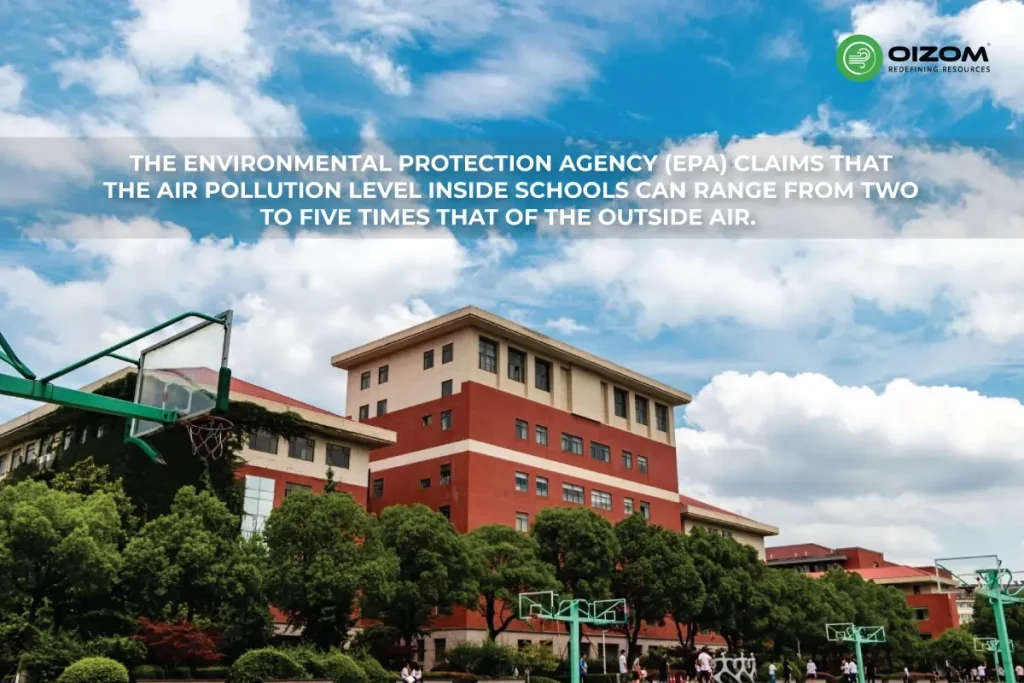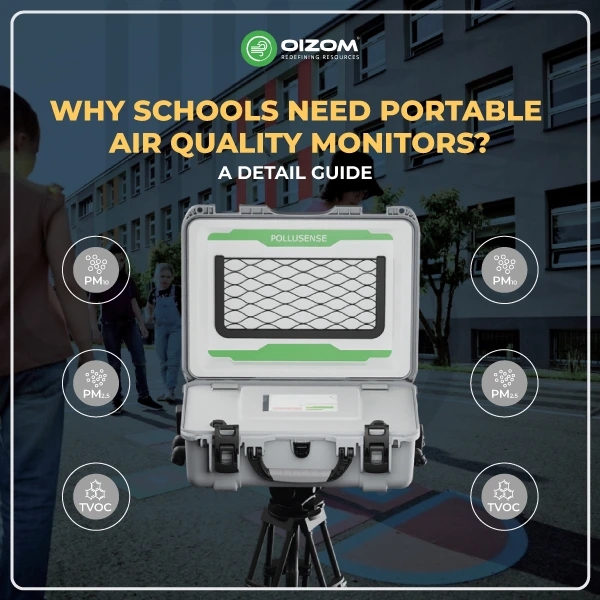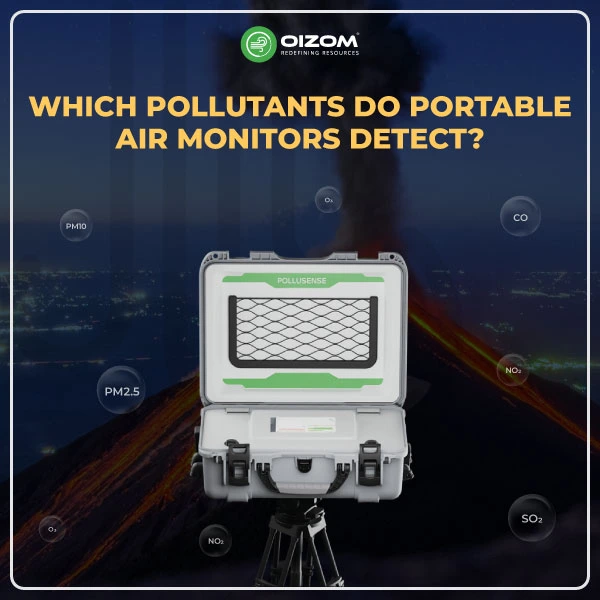10 Key Takeaway Points:
- Impact of Air Quality: Poor indoor air quality can impact students’ health, focus, and attendance, including respiratory issues and aggravated asthma.
- Rising Awareness: Since the pandemic, indoor air quality has become a priority for schools to create healthier learning environments.
- Benefits of Monitoring: Monitoring air quality allows schools to quickly address issues, reduce health risks, and create a supportive learning space.
- Real-Time Data: Real-time monitoring helps staff respond instantly to changes in pollutant levels, enabling prompt corrective actions.
- Portable and Flexible: Portable air quality monitors like Pollusense are easy to move between spaces, making them cost-effective and adaptable for schools.
- Multi-Parameter Detection: Advanced monitors can track multiple pollutants, providing a complete picture of air quality and specific contaminants.
- Data-Driven Insights: Collecting and analyzing data helps schools make informed decisions, adjust ventilation, and reduce pollution sources.
- Educational Value: Monitoring air quality protects students and raises awareness about environmental health in the school community.
- Ease of Use: Features like easy setup, long battery life, and reliable storage make portable monitoring systems user-friendly and efficient.
- Proactive Steps: Investing in air quality monitors is a proactive measure towards cleaner, healthier campuses, supporting academic success and even promoting green campus initiatives.
Why Schools Need Portable Air Quality Monitors? A Detail Guide
Imagine this: students feeling depressed, unable to focus, and prone to more sick days than ever. Could the air they’re breathing be to blame? Until recently, around 2020, indoor air quality (IAQ) wasn’t a big concern for many schools, but the pandemic has shifted that perspective.
Poor IAQ doesn’t just spread illness faster. It can also aggravate conditions like asthma, which already affects 1 in 13 students, leading to increased absences and health risks.
Now, good air is a top priority for parents, teachers, and administrators who want healthier, safer classrooms. From dust and mold to outdoor pollution entering into indoor spaces, schools face various air quality challenges. Thankfully, many districts and local governments are stepping up with high-resolution campus monitoring systems, helping make better-informed decisions about IAQ and protecting students’ health.
In this blog, we’ll explore why air quality monitoring is essential for schools, the benefits of using portable air quality monitoring systems, key features to look for, and important factors to consider when choosing the right monitor for school environments.
Why do Schools Need Air Quality Monitoring?
Ensuring clean and healthy air in schools has a direct impact on student well-being and academic achievement. Poor indoor air quality can cause a variety of health concerns, including respiratory disorders, allergies, asthma, and even cognitive dysfunction. Monitoring air pollution levels allows schools to identify potential dangers, implement preventative measures, and offer a safe and conducive learning environment for students and staff.
The Environmental Protection Agency (EPA) claims that the air pollution level inside schools can range from two to five times that of the outside air.

However, improving air quality in schools can result in a variety of short and long-term benefits, including fewer absences, asthma attacks, and flu transmission, increased schoolwork speed and performance, and higher math and reading test scores. Furthermore, for the first time in history, a UK coroner determined that a 9-year-old girl died as a result of poor air quality. The little girl was exposed to elevated amounts of nitrogen oxide and Particulate Matter 2.5 (PM2.5). As a result, she had severe asthma and acute respiratory failure.
However, the majority of kids lack a good knowledge of air quality. However, in today’s society, teaching your children about air quality is essential. You protect kids from the effects of bad air quality not only today but for the rest of their lives.
Benefits of Using Portable Air Quality Monitoring Systems in Schools

Portable air quality monitoring systems are a practical solution for schools to keep track of the air students and staff breathe. These devices help detect pollutants like dust, mold, and carbon dioxide, which can impact students’ health and focus. With real-time data, schools can respond immediately by improving ventilation or identifying areas that need attention, creating a healthier space.
A key advantage of portable monitors is that they’re easy to move around, giving schools a full picture of air quality in different classrooms and areas without the need for multiple fixed devices. They’re also budget-friendly, making them an accessible option for many schools.
By monitoring air quality in schools, it can reduce triggers for asthma, lower the spread of illnesses, and create a safer, more supportive learning environment for everyone.
1) Real-time Monitoring of Air Quality Levels
Real-time air quality is the measurement and reporting of air pollution levels in the present moment rather than using previous data or anticipated forecasts. We can get this information by using portable air quality monitoring devices. This technology can detect the presence of various contaminants in the air and broadcast that information in real-time to a central location or application. The data aids in alerting individuals and school administrators to potential health risks. It helps to guide decisions about when and where to employ pollution-reduction measures.
2) Early Detection of Pollutants and Gases
Early detection of pollutants and hazards is crucial in schools to protect children and professors and protect the environment.
By identifying pollutants like dust, volatile organic compounds (VOCs), and harmful gases (such as CO2 and NO2) early on, schools can determine and act swiftly to control exposure, reducing health risks for everyone in school.
Portable air quality monitors make this possible by providing real-time data on pollutant levels. This data helps teams adjust activities and implement safety measures proactively. Early detection safeguards kids’ health and ensures compliance with environmental standards, creating a safer, cleaner environment inside and outside the schools.
Did you know: As Per the American Psychiatric Association (APA), early exposure to air pollution can pose a significant risk in the onset of specific disorders such as depression, schizophrenia, bipolar disorders, and even some personality disorders.
3) Flexible and Cost-effective Solution
While safety should never be compromised, budgetary constraints are real. Balancing the necessity for accuracy, responsiveness, and other qualities against available funds might help to guide the decision. However, always favor critical features over price.
Low-cost sensors are valuable for establishing sensor networks because they are more affordable in buying and operations costs, flexible in probability, and scalable. They also can potentially complement reference-grade monitors in the region with more data points.
Oizom’s portable air quality monitoring system is reliable and accurate, providing a more cost-effective alternative to existing reference stations, unlike expensive reference stations, which can hinder implementation due to their high cost and occupancy.
Oizom’s technology offers a financially practical solution while maintaining performance. This portability results in more thorough air quality data collecting and proactive environmental management. With Oizom, communities can now afford to monitor air quality effectively, achieving the goals of a healthier environment in smart cities, schools, industries, construction sites, and so on.
Key Features of a Portable Air Quality Monitoring System for Schools
When choosing a portable air quality monitoring system for schools, there are a few key features that make a big difference.
First, real-time data is essential. Schools need quick, up-to-date information on pollutants like dust, carbon dioxide, and volatile organic compounds (VOCs) to react promptly when levels spike. Portable monitors with real-time alerts help staff respond fast to create a healthier environment.
Another crucial feature is ease of use. Portable monitors should be simple to set up, read, and move across classrooms, making it easy for school staff to assess air quality in different areas.
Oizom Pollusense, for example, is simple to set up with a warm-up time of up to 30 minutes for gas monitoring and 15 minutes for noise and PM monitoring. It has a Battery life of 24 hours, which also matters in monitoring. The long-lasting batteries can run throughout the school day without frequent recharging.
Lastly, data storage and connectivity are valuable. With Oizom Pollusense, you don’t need to worry about storage, as it comes with 16 GB of internal storage.
Connecting to a centralized system helps schools track air quality trends over time, allowing them to make informed decisions about ventilation or cleaning routines. With these features, portable air quality monitors become powerful tools for schools, supporting the well-being and productivity of students and staff.
- Lightweight and Portable Design
A lightweight and portable design is ideal for air quality monitors in schools. It makes moving the device between classrooms easy, so staff can check air quality in different spaces without effort. Compact and portable monitors fit in anywhere, taking up minimal space and allowing flexible use.
This portability is also budget-friendly since one device can serve multiple areas as needed. With a simple, user-friendly design, lightweight monitors help schools keep air quality in check wherever students learn and play.
- Multi-parameter Detection
Multi-parameter detection is a valuable feature for school air quality monitoring, allowing one device to measure multiple pollutants like dust, carbon dioxide, VOCs, and noise.
This provides a complete view of the air quality in classrooms. With real-time data on different pollutants, school staff can quickly adjust ventilation or address specific issues as they arise. This all-in-one solution makes monitoring easier and more effective, helping create a healthier learning environment by keeping track of the various factors that impact students’ health and concentration throughout the day.
Data Logging and Analysis
Modern monitors often come with features that allow for data logging and connectivity. These features can benefit long-term trend analysis, remote monitoring, and integration with other safety systems.
Regarding data transmission, our devices exhibit remarkable flexibility, supporting a wide array of Wired and Wireless channels. They are equipped to communicate wirelessly using Satellite, GSM, GPRS, 3G, 4G, WiFi, LORA, LTE, and SIGFOX technologies. For wired connectivity, they offer reliable Ethernet, Modbus, RS-485, and RS-283 options.
The crucial data on ambient air pollutants collected by our devices are efficiently transmitted to the Oizom Cloud Envizom, which can operate on either Shared or Private Infrastructure. This data is instrumental in powering diverse data solutions tailored to specific end applications.
Working Mechanism of Portable Air Quality Monitors in Schools
Portable air quality monitors are pretty cool. They detect and measure pollutants in the air around you. They’re packed with sensors that track specific things like particulate matter (PM), gases like CO2, NO2, ozone, and even environmental factors like temperature, humidity, and pressure. These sensors gather data in real-time, giving you an immediate snapshot of the air quality at any moment.
These devices typically use laser-based or electrochemical sensors, NDIR, and PID to measure pollutant levels.
For example, laser sensors detect particulate matter by measuring how light scatters when it hits particles in the air. Electrochemical sensors measure gases by reacting chemically with pollutants, producing an electrical signal.
What really makes portable monitors stand out is their mobility. Unlike fixed monitors, you can use them anywhere from school to university, providing flexible and immediate air quality assessments. Many also feature wireless connectivity to send real-time data straight to your smartphone or cloud platforms for easy analysis.
1) Sensor Technology Used in Portable Air Quality Monitors
The sensors are at the heart of these monitors, which measure various pollutants. It uses laser-based sensors to detect particulate matter (PM1, PM2.5, PM10, and PM100) and electrochemical, NDIR, and PID sensors to measure gases like nitrogen dioxide (NO2), ozone (O3), and volatile organic compounds (VOCs).
2) Air Intake and Measurement Process
The air intake and measurement process is crucial for accurate air quality monitoring. This process involves drawing in air through a specially designed intake system that filters out large particles, ensuring only fine particles and gases are measured.
Once inside, sensors analyze the air for pollutants like dust, gases, and other harmful particles, providing real-time data on air quality. A well-designed intake and measurement process ensures reliable, precise readings, allowing schools to monitor indoor air effectively.
Real-time Data Transmission and Alerts
Oizom Pollusense is designed to provide users with a seamless, reliable air quality monitoring experience, no matter the environment. Pollusense delivers accurate data continuously at construction sites, undeterred by harsh conditions.
Paired with Oizom’s Envizom, an advanced air quality visualization and analytics platform, users can access real-time data and insights. Powered by AI and Machine Learning, Envizom ensures precise data interpretation, enabling users to make informed decisions quickly and effectively.
Factors to Consider When Choosing a Portable Air Quality Monitor for Schools
When selecting a portable air quality monitor for schools, a few key factors can make a big difference. Accuracy is essential, and the monitor should reliably detect pollutants like dust, carbon dioxide, and VOCs that can affect students’ health. Ease of use matters, too; a device that’s easy to set up, read, and move between classrooms saves time for school staff.
Battery life is also important so the monitor can run all day without frequent recharging. Look for data storage and connectivity options, which help track air quality trends and allow for timely action. Lastly, a durable and lightweight design makes it easier to handle and transport. By considering these features, schools can choose a monitor that effectively supports a healthier learning environment.
Implementation and Best Practices for Using Portable Air Quality Monitors in Schools
Once you have identified a suitable air quality monitor for your school, it’s important to implement and utilize it effectively. The following are some best practices and considerations to keep in mind while implementing portable air quality monitors in schools:
- Conduct Preliminary Assessment
- Learn how to use portable air quality monitors
- Learn how to interpret IAQ and AQI Data
- Provide detailed staff training
Regular Calibration and Maintenance
Calibration and Maintenance are critical for ensuring reliable air quality measurements, especially in portable monitors. Calibration refers to the process of fine-tuning the sensors to match reference standards, ensuring that the data collected is accurate and trustworthy.
At Oizom, We prioritize data accuracy through a rigorous two-step pre-deployment calibration process. This calibration process ensures that our devices deliver precise and reliable air quality measurements from the moment they are deployed.
The initial step involves laboratory calibration in an ISO/IEC 17025:2017-certified environment. Our sensors are aligned with NIST traceable calibration gas standards and calibrated as per international U.S. EPA guidelines.
This initial calibration establishes a robust baseline for accurate data collection.Our particulate monitoring sensors are calibrated with reference stations, housing BAM-1020 for PM (- β-ray Attenuation), which significantly enhances the data accuracy and reliability of our sensors, ensuring high-quality air quality monitoring results.
To further refine sensor performance, devices undergo collocation calibration. Our devices are Deployed alongside a custom-built reference station equipped with EPA-designated Federal Equivalent Method (FEM) sensors. This side-by-side data evaluation allows us to identify and rectify any minor deviations, optimizing data quality and ensuring alignment with industry benchmarks.
We also offer on-site calibration as an option to maintain ongoing accuracy in diverse environmental conditions. For on-site calibration, one can use standard calibration gas cylinders or co-locate our fresh device with a reference standard. This will help our clients understand and ensure that our devices consistently deliver accurate data, regardless of deployment location or environmental factors.
Conclusion
Monitoring air pollution levels allows schools to proactively tackle indoor and outdoor air quality issues within campus, building a healthier, more focused learning environment. With reliable air quality data, schools can implement targeted actions to improve ventilation, reduce pollutants, and even educate students and staff about the importance of good air.
This data also creates opportunities to work with local authorities, building community support for healthier school spaces. Plus, it gives parents peace of mind, knowing their children breathe good air.
While air quality may be invisible, its impact is not. Investing in a portable air quality monitor like pollusense, which is powerful and portable. It is designed to monitor up to nine gases and particulate matter (PM1, PM2.5, PM10, and PM100) with real-time data, a long-lasting battery, and a rugged, portable design that’s easy to set up and move between spaces. This is a proactive step toward better well-being and academic performance for students.
While there’s no instant solution for air pollution, every step brings us closer to a cleaner, safer environment for our schools and even the possibility of achieving a green campus rating.






